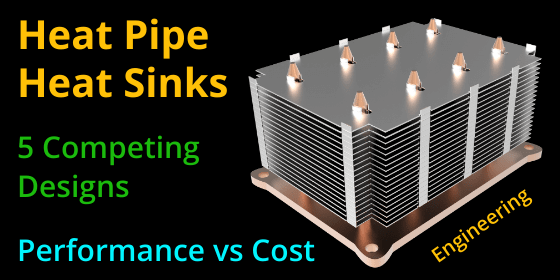Summary: This article compares 5 heat pipe heat sink designs for cost and performance:
- Heat pipe heat sink with a solid aluminum base plate
- Heat pipe heat sink with a solid copper base plate
- Heat sink where heat pipes make direct contact with the heat source
- Vapor chamber heat sink making direct contact with the heat source
- 3D vapor chamber heat sink making direct contact with the heat source
High-efficiency heat sink designs often include the use of heat pipes or vapor chambers. However, variations in two-phase design choices affect performance and cost significantly. Today, we’ll take a look at an application where the fins are stacked horizontally, requiring the heat pipe or vapor chamber to be routed through each of the fins. See “Heat Sink Design Options” for solid metal and heat pipe heat sink designs where the fins are vertical.
For this article, cost is based not on a nominal dollar figure (as it changes dramatically based on volume) but on the relative cost increase from one heat sink design to another. For instance, the lowest-cost solution is assigned a value of 1.0X while a heat sink that costs 20% more is assigned a value of 1.2X. This method should provide engineers with a good idea of cost premiums regardless of mass production volume.
Heat Pipe Heat Sink Design: Thermal Solution Parameters
- Heat source power: 250 watts
- Heat source size: 30×30 mm
- Max Tcase: unspecified but we can assign hypothetical values to see how the thermal budget changes and what effect that has on heat pipe heat sink design choice.
- Max ambient temp: 25 oC
- Available airflow: 40 CFM
- Condenser: zipper fin size 115*85*65 mm with fins running horizontally
For those mechanical engineers less familiar with why Max Tcase is important, here’s a quick explanation. Max Tcase temperature minus max ambient gives us the “thermal budget”. This figure must be above the heat sink Delta-t calculation to determine go/no-go performance. For instance, a thermal budget of 40 oC requires that the max heat sink delta-T from case TIM to fin-to-air temperature rise be below 40 oC.
Heat Pipe Heat Sink Designs #1 and #2: Solid Aluminum vs Solid Copper Base
This is the most traditional heat pipe heat sink design. Thermal grease/pad is used between the heat source and the bottom of the solid aluminum or copper base plate. The heat pipes are soldered to the base plate. This example shows slightly flattened pipes, but round heat pipes can be used if groves for each heat pipe are cut into the base plate. A heat pipe design guide provides more detail.
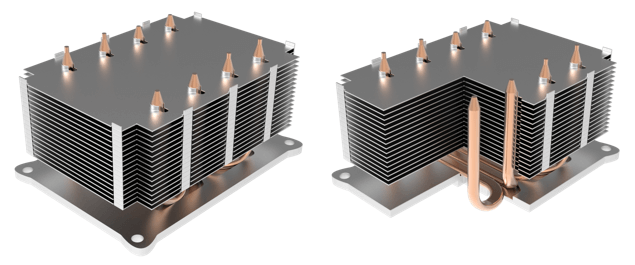
U-Shaped Heat Pipe Heat Sink with Solid Aluminum or Solid Copper (not shown) Base
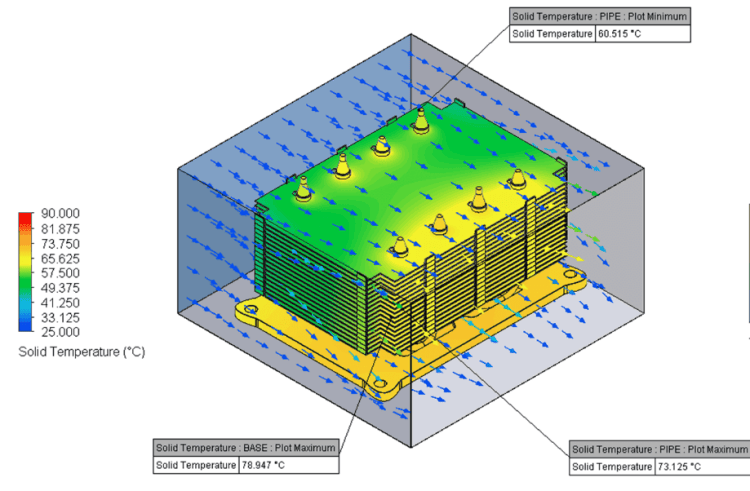
CFD of Heat Pipe Heat Sink Design with Aluminum Base
The FloTherm model for the heat sink with the aluminum mounting plate solution shows a temperature rise above ambient of 53.9 oC (78.9 – 25oC = Base Maximum – Max Ambient). Dividing the heat sink temperature rise (53.9) by the heat source power (250 watts) tells us the thermal resistance of this heat pipe heat sink: 0.2156 oC/watt. For these examples, this is the low-cost solution, so its cost baseline is 1.0X.

Heat Pipe Heat Sink Cost & Performance of Solid Base Designs
If more heat sink performance is required, a copper base plate can replace the aluminum one. With thermal conductivity approximately twice that of aluminum, the copper base improves heat sink performance by 2.3 oC to 51.6 oC. This design is 5% more expensive than the baseline so its relative cost adder is 1.05X that of the low-cost solution.
Heat Pipe Heat Sink Design #3: Direct Contact Heat Pipes

Direct Contact Heat Pipe Heat Sink
This thermal solution allows the heat source to make direct contact with the heat pipes, eliminating the base plate (in terms of conduction) and the solder interface between the heat pipes and the base plate. However, in order to achieve the necessary surface flatness, the heat pipes must be machined or fly cut, adding cost.
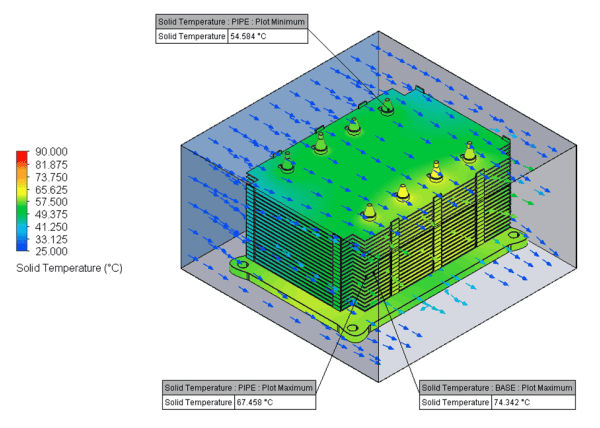
CFD Direct Contact Heat Pipes
Because the thermal pathway is reduced by one base plate and one solder interface, the delta-T of this heat pipe heat sink design improved to 49.3 oC; a 4.6 degree improvement over the baseline and a 2.3 degree improvement over the design using the copper base plate (heat sink thermal resistance = 0.1972 oC/watt). However, the additional machining of the base plate (room for HP to stick through) and machining of the heat pipes yields a cost of 1.1X that of the Baseline design (10% more expensive).

Heat Pipe Heat Sink Cost & Performance of Solid and Direct Contact Heat Pipe Bases
Heat Pipe Heat Sink Design #4: U-Shaped Direct Contact Vapor Chamber
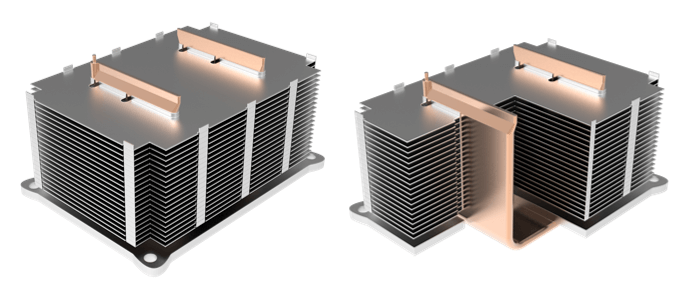
U-Shaped Vapor Chamber
Using a U-shaped vapor chamber, this heat sink design replaces four 6mm heat pipes. It’s most similar to the direct contact heat pipe solution as both designs allow the heat source to make direct contact with the two-phase device(s). An important consideration before choosing this thermal solution is whether the heat sink supplier is able to manufacture one-piece vapor chambers because the traditional two-piece design cannot be bent into a U-shape.
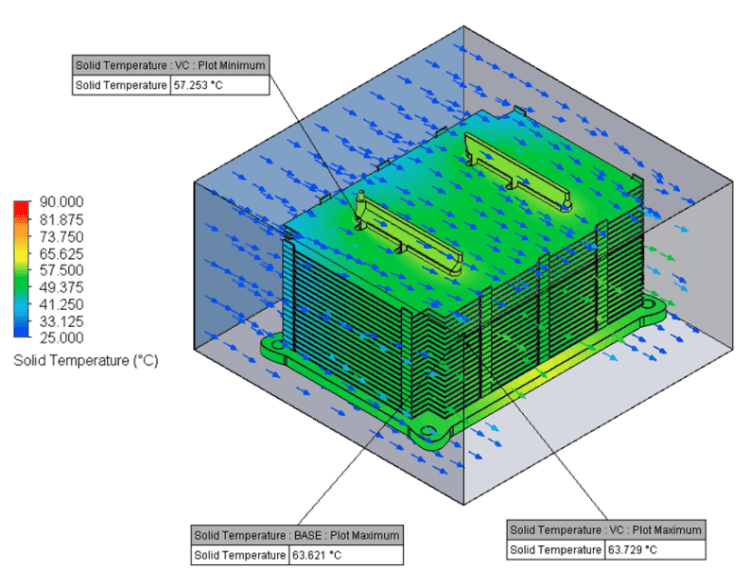
CFD U-Shaped Vapor Chamber Heat Sink
Versus the direct contact heat pipe solution, the vapor chamber thermal solution performs 21.5% better (11.6 oC lower heat sink delta-T) while only costing 4.5% more. However, the increased wall thickness of the vapor chamber drives a weight increase of around 75 grams.

Heat Pipe Heat Sink Cost & Performance of Solid and Direct Contact Bases
Heat Pipe Heat Sink Design #5: 3D Vapor Chamber
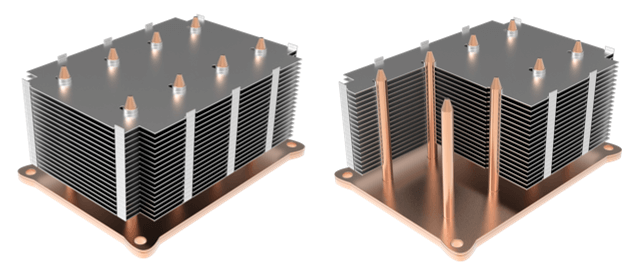
3D Vapor Chamber Heat Sink
The base plate is a vapor chamber with vertical condenser tubes sharing the same vapor space. It’s produced by brazing 8 open-ended condenser tubes to a vapor chamber with corresponding holes in it. The vapor chamber makes direct contact with the heat source spreading heat evenly along the XY planes and vertically through the condenser tubes.

CFD 3D Vapor Chamber
This 3D vapor chamber heat sink design has the best performance, but at a considerable cost premium. Versus its next closest competitor, the vapor chamber design, the 3D version is almost 2 degrees cooler (a 4.9% gain) but costs over twice as much (117% more).
It should be noted that this application does not fully highlight the potential benefits of a 3D vapor chamber design. As the size of the required base plate increases, the performance difference between this solution and a U-shaped vapor chamber increases as well.

Heat Pipe Heat Sink Design Cost & Performance of All Options
The table above shows that substantial performance gains are realized as materials or two-phase devices are changed. From the baseline aluminum base heat sink to the 3D vapor chamber solution, there’s a 17 oC performance improvement but cost increases by 150%.
Modest performance gains and cost adders, vs baseline, of around 7-15% are achieved by changing the base plate to a more thermally conductive copper material or by allowing the heat pipes to make direct contact with the heat source.
Given the application parameters, the best overall value is probably the U-shaped vapor chamber cooling solution. Although it’s 15% more expensive than the baseline, performance is increased by 28% (15.2 oC improvement).
Celsia is a custom heat sink manufacturer using vapor chamber and heat pipe technology. We specialize in: heat sink design, heat sink proto, heat sink manufacturing, heat pipes, vapor chambers, custom heat pipe wick materials.

